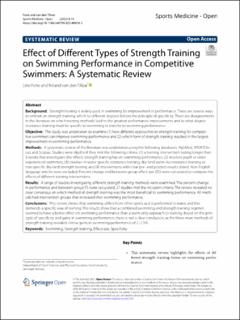| dc.contributor.author | Fone, Line | |
| dc.contributor.author | van den Tillaar, Roland Johannes Wilhelmus | |
| dc.date.accessioned | 2023-02-08T07:52:12Z | |
| dc.date.available | 2023-02-08T07:52:12Z | |
| dc.date.created | 2022-02-03T15:40:37Z | |
| dc.date.issued | 2022 | |
| dc.identifier.citation | Fone, L. & van den Tillaar, R. (2022). Effect of different types of strength training on swimming performance in competitive swimmers: A systematic review. Sports Medicine - Open, 8, Article 19. doi: | en_US |
| dc.identifier.issn | 2198-9761 | |
| dc.identifier.uri | https://hdl.handle.net/11250/3049084 | |
| dc.description.abstract | Background: Strength training is widely used in swimming for improvement in performance. There are several ways to embark on strength training, which to different degrees follows the principle of specificity. There are disagreements in the literature on which training methods lead to the greatest performance improvements and to what degree resistance training must be specific to swimming to transfer to swimming performance. Objective: The study was undertaken to examine (1) how different approaches to strength training for competi- tive swimmers can improve swimming performance and (2) which form of strength training resulted in the largest improvement in swimming performance. Methods: A systematic review of the literature was undertaken using the following databases: PubMed, SPORTDis- cus and Scopus. Studies were eligible if they met the following criteria: (1) a training intervention lasting longer than 3 weeks that investigates the effects strength training has on swimming performance, (2) involves youth or older experienced swimmers, (3) involves in-water specific resistance training, dry-land swim-like resistance training or non-specific dry-land strength training and (4) interventions with clear pre- and posttest results stated. Non-English language articles were excluded. Percent change and between-group effect size (ES) were calculated to compare the effects of different training interventions. Results: A range of studies investigating different strength training methods were examined. The percent change in performance and between-group ES were calculated; 27 studies met the inclusion criteria. The review revealed no clear consensus on which method of strength training was the most beneficial to swimming performance. All meth- ods had intervention groups that increased their swimming performance. Conclusions: This review shows that swimming differs from other sports as it is performed in water, and this demands a specific way of training. The results show that a combined swimming and strength training regimen seemed to have a better effect on swimming performance than a swim-only approach to training. Based on the prin- ciple of specificity and gains in swimming performance, there is not a clear conclusion, as the three main methods of strength training revealed similar gains in swimming performance of 2–2.5%. | en_US |
| dc.language.iso | eng | en_US |
| dc.publisher | Springer | en_US |
| dc.rights | Navngivelse 4.0 Internasjonal | * |
| dc.rights.uri | http://creativecommons.org/licenses/by/4.0/deed.no | * |
| dc.title | Effect of different types of strength training on swimming performance in competitive swimmers : A systematic review | en_US |
| dc.type | Peer reviewed | en_US |
| dc.type | Journal article | en_US |
| dc.description.version | publishedVersion | en_US |
| dc.rights.holder | © 2022 The Authors | en_US |
| dc.source.pagenumber | 26 | en_US |
| dc.source.volume | 8 | en_US |
| dc.source.journal | Sports Medicine - Open | en_US |
| dc.identifier.doi | 10.1186/s40798-022-00410-5 | |
| dc.identifier.cristin | 1997493 | |
| dc.source.articlenumber | 19 | en_US |

